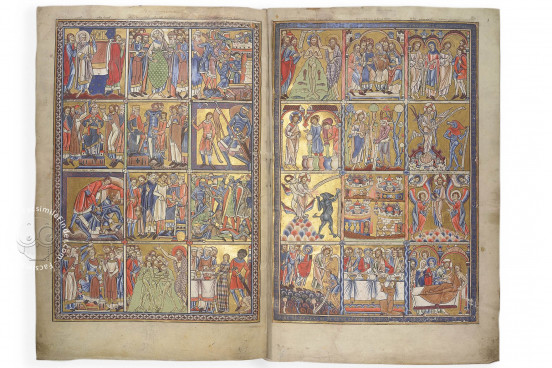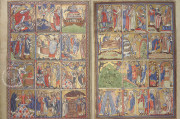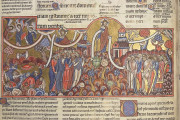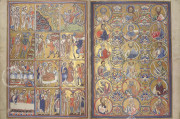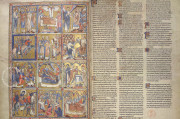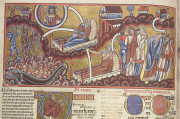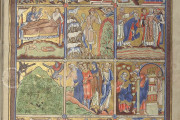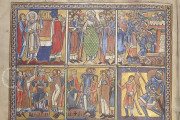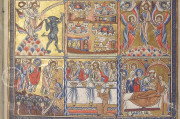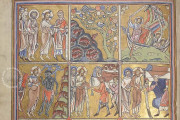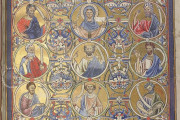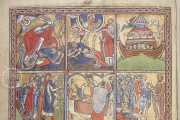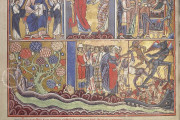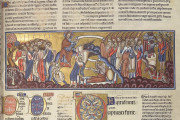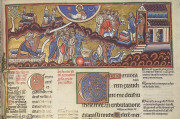Begun in the late twelfth century, the Great Canterbury Psalter, also known as the Paris Psalter, is the last English artistic "copy" of the Utrecht Psalter, a Carolingian illuminated book of the biblical psalms. The manuscript—started at Christ Church, Canterbury, and completed in the mid-fourteenth century in Catalonia—presents the three Latin versions of the psalms attributed to Saint Jerome in three columns, accompanied by interlinear and marginal translations and glosses. Little expense was spared on the lavish decoration, which features an abundance of gold and vivid colors.
In its final state, the manuscript boasts eight full-page prefatory miniatures and ninety-nine miniatures illustrating the psalms, most of which extend across the full width of the page. There are thirty-five historiated initials and more than 200 zoomorphic, inhabited, and decorated initials.
Inspiration from a Carolingian Masterwork
It is unmistakable that the ninth-century Utrecht Psalter, which arrived in Canterbury by 1000, made a great impression on its medieval viewers there. The Great Canterbury Psalter is one of three manuscripts created at Christ Church in the eleventh and twelfth centuries with image cycles based on the illustrations in the Utrecht Psalter. In all three, selected words and phrases of each psalm are visualized in a coherent composition that heads the psalm text.
English and Catalan Production
The ambitious plan for the psalter was to provide an image to illustrate each psalm. That plan was not fully realized at Christ Church, and the manuscript left the monastery unfinished. At Canterbury, the scribe wrote the text through Psalm 98:6 (Vulgate), ending in medias res. The Canterbury artist only reached Psalm 57, with several of the images left as underdrawings.
The codex emerged in Catalonia in the fourteenth century and was outfitted with its originally planned large miniatures and painted initials through to the end of the text as written at Canterbury. This illumination has been attributed to the circle of Ferrer Bassa, a group of artists also confusingly identified as the "Master of San Marcos." Bassa, court painter to the kings of Aragon, contributed to the illumination of the Book of Hours of Maria of Navarre.
A Multi-Lingual Text
The text of the Great Canterbury Psalter is the work of a single scribe writing in Transitional Script of various sizes. The Gallican version of the psalms—named for its widespread diffusion through the Carolingian empire—occupies the widest column and is written in the largest script. It is accompanied by a marginal and interlinear gloss.
The script of the other two Latin versions of the psalms, the Roman and Hebraicum, is smaller. The Roman version features four fragments of an Old English translation in between the lines, and the Hebraicum version has an interlinear translation into Anglo-Norman French.
Royal Patron(s)?
The patron of the original Great Canterbury Psalter and the reason the initial work came to halt are unknown. Scholars have suggested possible royal patrons, but there is no consensus. Work on the manuscript was likely stopped with the removal of financial resources.
The codex probably owes the renewal of its illumination to Pedro IV (d. 1387), the "Ceremonious," King of Aragon, engaging the workshop of his court painter. The manuscript was in the library of Margaret of Austria (1480-1530), Regent of the Netherlands, and her niece Maria (1505-1558), Queen Consort of Louis II, King of Bohemia and Hungary, whose library became a part of the ducal library of Burgundy in Brussels.
Napoleonic Binding
The Great Canterbury Psalter once bore a binding of green velvet with the coat of arms of Maria of Hungary. When the contents of the Burgundian ducal library were acquired by the French in 1794, the manuscript was removed to Paris, where it has remained since. At that time, it received a binding made for Napoléon I (1769-1821). The current conservation binding was supplied in 2017.
We have 1 facsimile edition of the manuscript "Great Canterbury Psalter": Salterio Glosado facsimile edition, published by M. Moleiro Editor, 2006
Request Info / Price
